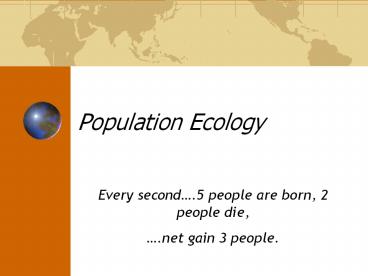Population Ecology - PowerPoint PPT Presentation
1 / 52
Title:
Population Ecology
Description:
Population Ecology Every second .5 people are born, 2 people die, .net gain 3 people. Developed countries 1. Low birth rates 2.Low infant mortality rates. – PowerPoint PPT presentation
Number of Views:351
Avg rating:3.0/5.0
Title: Population Ecology
1
Population Ecology
- Every second.5 people are born, 2 people die,
- .net gain 3 people.
2
Population Ecology
- Deals with the of individuals of a particular
species that are found in an area and how and why
those change or remain fixed over time.
3
Population ecologists study
- How populations respond to its environment
- Competition for resources, predations, disease
and other environmental pressures
4
Population Growth
- J-shaped curve
- 1. Exponential growth growth rate under ideal
conditions - 2. Uncheck growth (carrying capacity not yet
met)
5
J-shaped
- Exponential growth!
6
S-Shaped Curve
- 1. An S-shaped curve shows that the population
grows slowly at first then increases more and
more quickly.
7
S-Shaped Curve
8
- 2. At carrying capacity, growth of the
population will remain the same.
9
- 3. Carrying capacity is the number of organisms
that an environment can support indefinitely.
10
- a. Births will approximately equal deaths.
- B. When the population overshoots the carrying
results in LIMITING factors death to outnumber
births.
11
- C. Limiting Factor is a factor that will limit
population growth. - 1) Food availability
- 2) Disease
- 3) Predators
- 4) Space
12
Reproductive Patterns
- A. Rapid life history (example mosquitoes)
- a. Rapid reproduction
- b. High number of offspring
13
Reproductive Patterns
- c. Small body size
- d. Organisms mature rapidly
- e. Reproduce early
- f. Organisms have a short life span
14
- B. Slow life history (example elephant)
- a. Slow reproduction
- b. Low number of offspring
- Large body size
15
- d. Organisms mature slowly
- e. Reproduce late in life
- f. Organisms have a long life span
- g. Organisms tend to have parental care
16
Population density growth
- Population density is the number of individuals
in a given area.
17
- DensityDEPENDENT factor
- Factor that limits population size or density
18
- A. Disease (example HIV)
- B. Competition
- C. Predators
- D. Parasites
- Food
- Water
- Territory
19
- Density -INDEPENDENT factor
- Usually a weather related event.
- It affects ALL populations regardless of size.
20
- A. Temperature
- B. Storms
- C. Floods
- D. Drought
- E. Volcanic eruption
21
- Predator-prey relationship
- Predators affect prey populations
- B. Prey affect predator populations
22
- Intraspecies competition
- A. Space
- B. Food
- C. Water
- D. Reproduction
23
- Invasive Species
- uncontrolled competition
24
Project World Population Growth
- Demography
- Study of HUMAN population size, density,
distribution, movement, BIRTH rates death rates.
25
World Population Growth
26
Year Population
1 200 million
1000 275 million
1500 450 million
1650 500 million
1750 700 million
1804 1 billion
1850 1.2 billion
1900 1.6 billion
1927 2 billion
1950 2.55 billion
1955 2.8 billion
1960 3 billion
1965 3.3 billion
1970 3.7 billion
1975 4 billion
1980 4.5 billion
1985 4.85 billion
1990 5.3 billion
1995 5.7 billion
1999 6 billion
2006 6.5 billion
2009 6.8 billion
2011 7 billion
2025 8 billion
2050 9.4 billion
27
- Humans can alter their environment thus affect
the POPULATION GROWTH RATE.
28
- 1. Famine
- 2. Eradicate Disease
- 3. War
- 4. Better food production
29
Calculating Growth Rate
- Growth rate (r) birth rate (b) I death rate
(d) E
30
- Immigration movement of individuals into a
population - Emigration movement of individuals into a
population
31
- Doubling time time needed for population to
double in size - Zero population growth birthrate death rate
32
- Birthrate number of live births per 1000 in a
given year - Death rate number of deaths per 1000 in a
given year
33
Demographics of Countries
- Demographics applied science that deals with
population statistics.
34
Developed countries
- 1. Low birth rates
- 2.Low infant mortality rates. (the of infant
deaths per 1000 live births)
35
Developed countries
- 1996 US 7.5/1000 for infant morality
- World average 62/1000
36
Developed countries
- 3.Usually have longer life expectancy
37
Developed countries
- 4.Examples of developed countries
- US, Canada, Sweden, Germany, France, Australia,
Japan
38
Developing Countries
- Moderately developed countries
- Examples
- 1. Mexico
- 2. Turkey
- 3. Thailand
- (most S. American nations)
39
- Less developed countries
- Examples
- 1. Bangledesh
- 2. Niger
- Ethiopia
- Laos
- Cambodia
40
- These countries have
- High birth and mortality rates than developed
countries - Short life spans
41
- Another factor to examine is the replacement
level fertility. This is number of children a
couple must have to replace themselves.
Replacement rate is 2.1 children in developed
countries.
42
- The replacement rate in developing countries is
2.7 children.
43
Age Structure of Countries
- In order to predict future population it is
important to know the age structure.
44
Age Structure of Countries
- Age structure is the number and proportion at
each age in a population. The number of males
and females at each age.
45
- The overall structure of the age tells whether
the population is increasing, stable or shrinking.
46
- Stable growth approximately the same number of
individuals at each age grouping
47
- Rapid growth a large proportion of the
population is 19 years old or younger
48
- Slow growth a large proportion of population is
55 years old or younger
49
- Declining growth the largest portion of the
population is 20-40 years, smaller groups are
younger
50
(No Transcript)
51
(No Transcript)
52
(No Transcript)































